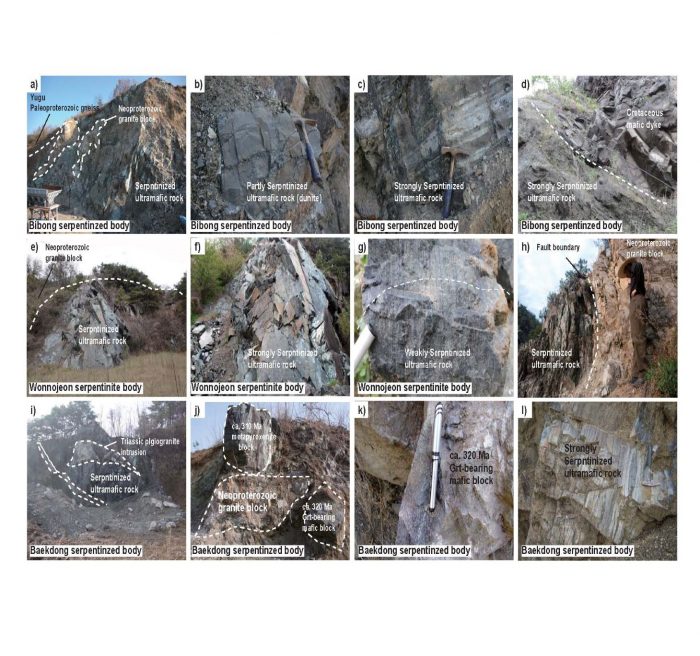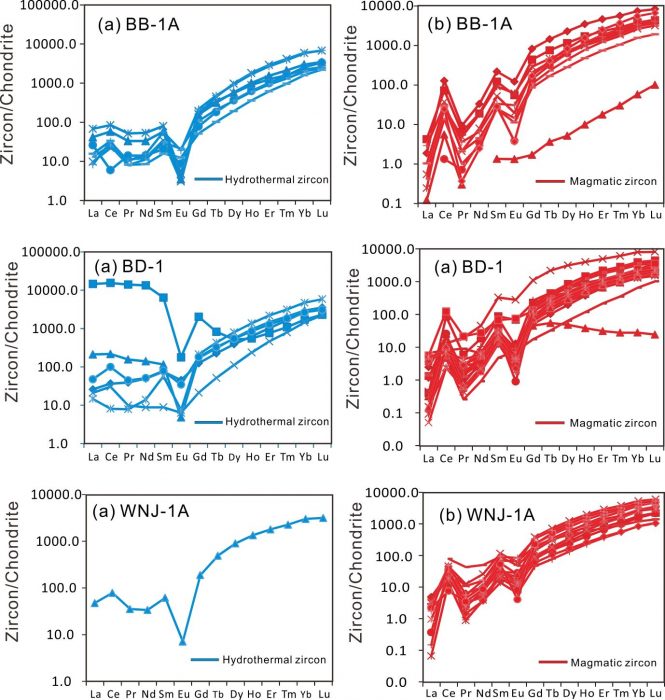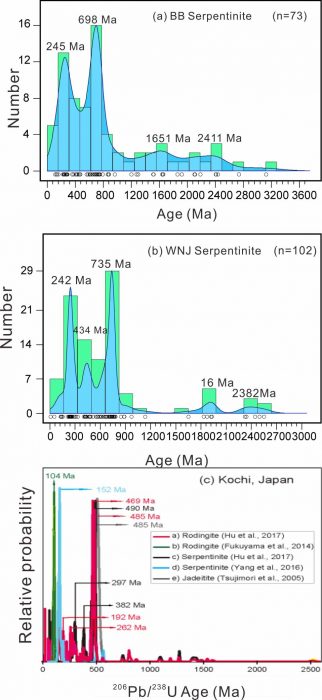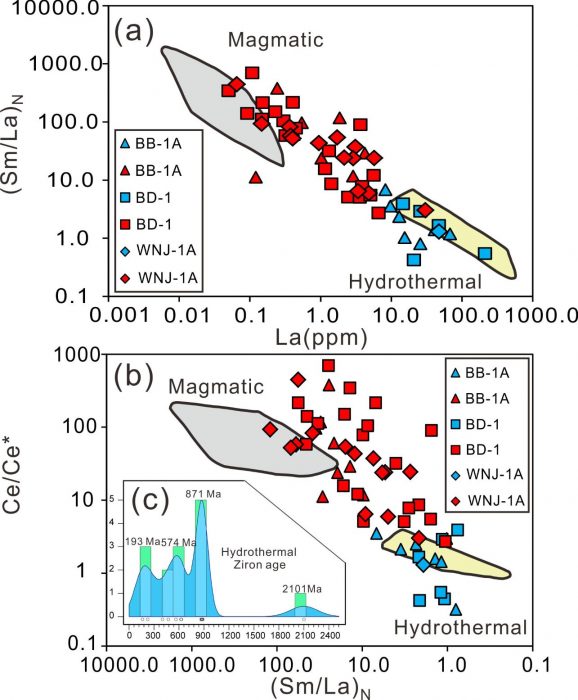
The Asian continental collage was formed by the assembly of several continental fragments through multiple subduction-accretion-collision processes. These prolonged tectonic cycles left their imprints on the East Asian mantle domain. The paper by Wang et al. (2019) attempts to investigate the magmatic and metasomatic processes in the mantle wedge beneath South Korea, a central region which was significantly affected by multiple subduction processes, including the ongoing subduction of the Pacific ocean lithosphere from the east. They used the isotopic composition of zircon retrieved from exhumed mantle slices to image these processes.

Fig. 1: Outcrop photographs showing the Bibong, Wonnojeon and Baekdong serpentinized ultramafic bodies in the Heongsong Belt of South Korea. (a) –(d) the Bibong body surrounded by the Paleoproterozoic Yugu gneiss consists of weakly to strongly serpentinized ultramafic rock. The body includes ca. 760–730 Ma Neoproterozoic alkali granite block and is intruded by ca. 110 Ma Cretaceous andesitic dyke and basaltic rock. (e) –(h) The Wonnojeon body surrounded by Neoproterozoic alkali granite, consists mostly of strongly serpentinized ultramafic rock. The boundary between the Wonnojeon body and the Neoproterozoic alkali granite shows fault contact. (i)-(l) The Baekdong body surrounded by Neoproterozoic alkali granite and composed mostly of strongly serpentinized ultramafic rock. The body includes the Carboniferous HP mafic granulite blocks and is intruded by ca. 228 Ma plagiogranite (or anorthosite). Image republished with permission from https://linkinghub.elsevier.com/retrieve/pii/S1674987118301579 under a CC BY-NC-ND 4.0 license.
Zircon (ZrSiO4) is a common mineral found in many igneous and metamorphic rocks and is durable and largely resistant to physical and chemical corrosion. Zircon grains in rocks are tiny time capsules and can preserve the memory of several hundred millions of years. The cores of zircon grains remain unchanged and preserve the chemical characteristics of the rock in which it originally crystallized. Zircon is used as a geological clock because of its suitability as a geochronometer based on the decay of U (and Th) to Pb. In addition, it is also the major host of the radiogenic isotopic tracer Hf, and is also useful to determine the oxygen isotopic compositions and the concentration of Rare Earth and other trace elements, thus offering a potential proxy to trace the source characteristics and magma petrogenesis.

Fig. 2. Representative cathodoluminescence (CL) images of zircon grains from (a) serpentinite (BB-1A), (b) HP mafic granulite (BD-1) and (c) serpentinite (WNJ-1A). Zircon U–Pb ages (Ma) and εHf(t) values are also shown. The smaller yellow circles indicate spots of LA-ICP-MS U–Pb dating, whereas the larger red circles represent locations of Hf isotopic analyses. Image republished with permission from https://linkinghub.elsevier.com/retrieve/pii/S1674987118301579 under a CC BY-NC-ND 4.0 license.
Wang et al. (2019) focused on the southern part of the Hongseong–Imjingang Belt in the central-western Korean Peninsula, where dismembered serpentinized ultramafic and high-pressure mafic granulite blocks occur. The serpentinite and mafic rocks are keys to trace the tectonic evolution of the region. Wang et al. (2019) separated zircon grains from these rocks and carried out trace element analysis, LA-MC-ICPMS U-Pb dating, and Lu-Hf isotopic analyses. They differentiated magmatic zircon grains using the rare earth element data with characteristic light rare earth element (LREE) depletion and heavy rare earth element (HREE) together with their sharp negative Eu and Pr anomalies and positive Ce and Sm anomalies.
In contrast, the REE patterns of hydrothermal zircons in these rocks show LREE enrichment and relatively flat patterns with negative Eu anomaly. The few older zircon grains ranging in age from the Early to Middle Paleoproterozoic occurring in these rocks are considered represent detrital grains from the basement transferred to the wedge mantle through sediment subduction in an active convergent margin. The common Neoproterozoic age peaks are correlated with subduction-related melt-fluid interaction in the mantle wedge at this time. The more prominent Middle Paleozoic (Silurian 434 Ma) and the Triassic (242 to 245 Ma) age peaks correspond to Phanerozoic subduction events that added further melts and fluids into the ancient mantle wedge.

Fig. 3. Chondrite-normalized REE diagrams of zircons in sample BB-1A, BD-1, and WNJ-1A. (a) Hydrothermal zircon grains (b) magmatic zircon grains. Image republished with permission from https://linkinghub.elsevier.com/retrieve/pii/S1674987118301579 under a CC BY-NC-ND 4.0 license.

Fig. 4. Compiled zircon U–Pb ages using kernel density distribution plots for serpentinites from BB (a) and WNJ (b). The data include those from this study and previous works. (c) Compiled zircon age data on serpentinites, rodingites, and jadeitites from Kochi, SW Japan from previous studies. Image republished with permission from https://linkinghub.elsevier.com/retrieve/pii/S1674987118301579 under a CC BY-NC-ND 4.0 license.
Zircon Hf signature from the serpentinite show negative εHf(t) (-18.5 and -23.5) values indicating an enriched mantle source with TDM in the range of 1614 and 1862 Ma. Zircons from the high-pressure mafic granulite also show slightly negative εHf(t) (average -4.3) and TDM in the range of 1365 to 1935 Ma. Based on the U-Pb age data from the dismembered serpentinite and mafic bodies in the Hongseong area, compiled with data from previous studies, Wang et al. (2019) attempted to elucidate the growth of magmatic and hydrothermal zircons during multiple subduction events in the context of the Precambrian to Phanerozoic frameworks of the Sino-Korean Peninsula of East Asia.

Fig. 5. Discrimination plots for magmatic and hydrothermal zircon grains. (a) La–(Sm/La)N, (b) (Sm/La)N –Ce/Ce*, (c) all the hydrothermal zircon U–Pb data in this study using the kernel density distribution. Grey shaded area represents the magmatic field and yellow represents the hydrothermal field. The data indicate a transition from magmatic to hydrothermal zircons. Image republished with permission from https://linkinghub.elsevier.com/retrieve/pii/S1674987118301579 under a CC BY-NC-ND 4.0 license.
Their study provides important evidence for multiple zircon growth in an evolving mantle wedge that witnessed melt and fluid interaction during different orogenic cycles. Their data also compare with multiple zircon growth from active convergent margin mantle wedge such as in SW Japan.
These findings are described in the article entitled Magmatic and hydrothermal zircon growth during multiple orogenic cycles in an evolving mantle wedge, recently published in the journal Geoscience Frontiers.
Reference:
- Wang, J. Y., Santosh, M., Li, S. S., Kim, S. W. (2019). Magmatic and hydrothermal zircon growth during multiple orogenic cycles in an evolving mantle wedge. Geoscience Frontiers 10, 439-452.









